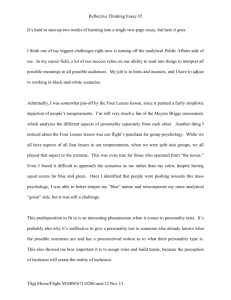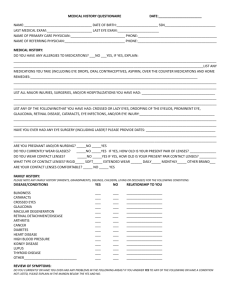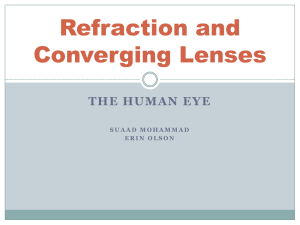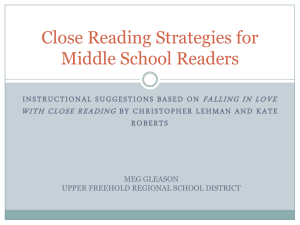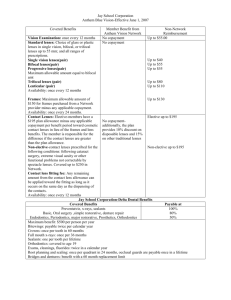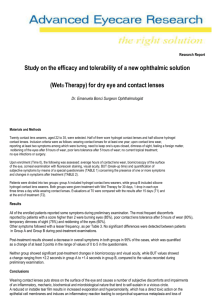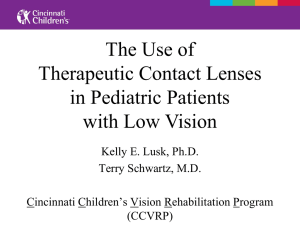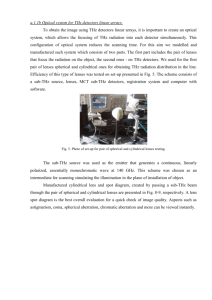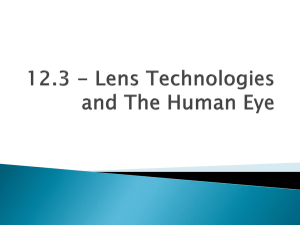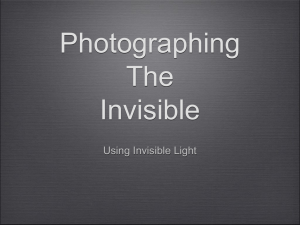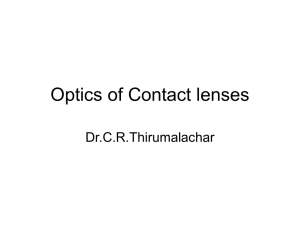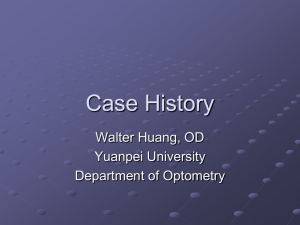Bee as seen by a mammal
advertisement
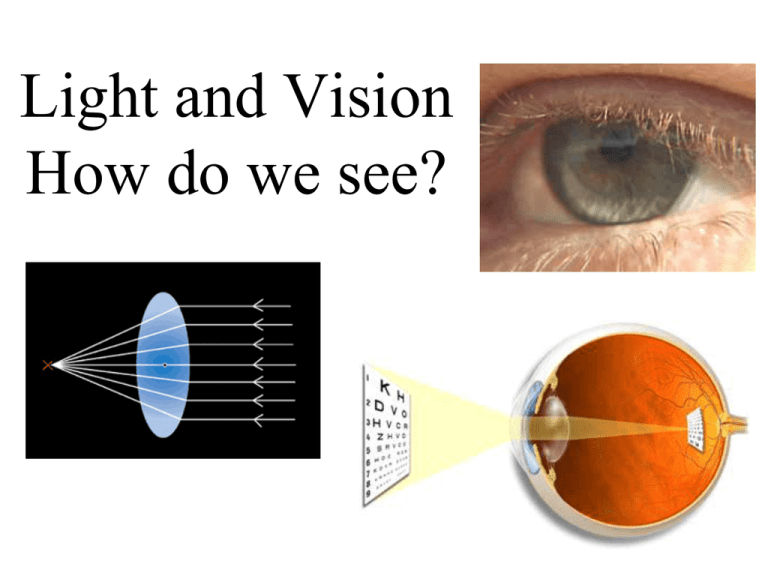
Light and Vision How do we see? The Electromagnetic Spectrum Things to Think About Today • • • • Light waves travel in straight lines until they meet matter Then, light is reflected, absorbed, refracted Why do animals have eyes? How did eyes evolve? What are the parts of the eye and how do they work to bend light Light Energy Meets Matter Refracted (Bent) Reflected Absorbed • Light waves travel in straight lines until they meet matter • Some matter ( lenses) focus rays and bend them in defined ways • Pin activity=Boxes with solutions/laser pointer, ray box • Ray boxes with lenses, gelatin lenses Convex Lenses Magnifying Lenses are Convex lenses Concave Lenses (divergent lenses) Eyes: Detect and Focus Light • Eyes are organs that detect light, and convert it to electro-chemical impulses in neurons • In higher organisms the eye is a complex optical system which: – collects light from the surrounding environment – regulates its intensity through a diaphragm – focuses it through an adjustable assembly of lenses to form an image – converts the image into a set of electrical signals – transmits these signals to the brain, through complex neural pathways that connect the eye, via the optic nerve, to the visual cortex and other areas of the brain. 3 types of eyes have evolved • Single centered lens – Advanced mollusks (octopus), spiders,vertebrates • Many tiny lenses – Arthropods (trilobites) – Ex. Ants (50 images) Horsefly (7,000 images) Dragonfly (30,000 images) • Hole without lens – snakes Parts of the Eye that you can See! Functions of Parts of the Eye • Eyelid- protection of eye from injury • Pupil- hole in the center of the iris that lets light in – Appears black because the eye tissue absorbs most of the light • Sclera-tough outer layer – collagen and elastin • Iris-colored area surrounding pupil – Composed of smooth muscle Interior Parts of the Eye Path of an Image • • • • Goes through the Cornea and Lens Hits the back of the retina Activates rod and cone cells Transmit impulse through optic nerve to the brain Rod and Cone Cells • Rod Cells- numerous ( 130 million in each eye – Responsible for Twilight vision, Gray shades – Very sensitive to light – Found on outside of retina • Cone Cells– less numerous • ( 7 million) – Responsible for – Ability to see Color – Found in center of the retina • (macula) Now, let’s think about what might go wrong Myopia- Near-sighted • • • • • Genetic Basis Eye is longer than normal, Cornea steeper Correct with glasses, contacts, surgery Very common! Can make it better by squinting!- Changes the eyeball shape! Myopia= Near Sightedness Hyperopia- Far-sighted • Image is focused behind the eyeball • Cornea is flatter, eye is shorter, focusing power is weaker • Young people can “accommodate” by changing shape of eye= As people get older, lens get harder and can’t be bent. • Lasix surgery changes shape of cornea – http://www.ncbi.nlm.nih.gov/pubmedhealth/PMH0004853/ Hyperopia+ Farsightedness Cataracts • Clouding of the lens • Caused by aging or damage to the proteins that make up the lens • Chemicals, Diabetes, Injury, Smoking are causative • Surgery to remove lens Normal/Cataract Retinitis Pigmentosa • Rare genetic disease (1/4000 people in US) • Rods die and leave dark deposits in retina • Lose peripheral and night vision Normal/Retinitis What about compound vision? A Grid- Seen by a Human and an Insect A spider web- seen by a human and an insect Bee as seen by a mammal and an insect Insect images Insects See Colors Differently http://www.naturfotograf.com/UV_flowers_list.html What about other animals? Bird Vision • How do nocturnal birds see? – Rod cells are very sensitive in low light • Humans have around 200,000/mm2, some owls have over a million/mm2 – Birds also have larger pupils which let more light in • What about day foragers – Have more cones than humans – May have more than one fovea area of sharpness) Ruminant Pupils • Slit-like in bright light, circular in dim light • Gives permanent wideangle vision whether in dim or bright light -makes watching for predators more efficient. Making the connection between physical science and biology • Light travels in straight lines • Light bends when it meets matter • Lenses are matter that bend light • How animals see • Eye diseases • Do you need light to see? • Ray box • Bending Experiment • Play with Lenses • Eye Dissection • Annenberg video Video by Discipline by Grade Teacher Resources/Education St udent s t ry t o explain where wood really comes from. A video document ary on educat ion and learning for K-12 educat ors and parent s; 3 one-hour video programs and guide N o w o n DVD Why don't even t he bright est st udent s t ruly grasp simple science concept s? These video programs pick up on t he quest ions asked in t he Privat e Universe document ary and furt her explore how children learn. Based on recent research, as well as t he pioneering work of Piaget and ot hers, M i n d s o f O u r O w n shows t hat many of t he t hings we assume about how children learn are simply not t rue. For educat ors and parent s, t hese programs bring new insight t o debat es about educat ion reform. Produced by the Harvard-Smithsonian Center for Astrophysics. 1997. I S B N : 1-57680-064-4 Overview Individual Program Descriptions Printable Page Buy Videos and Materials RReel a tt e d Re ssoouu r c e ss See all A Private Universe Private Universe Project in Science Private Universe Project in Mathematics Surprises in Mind A Private Universe Project Wrap up Questions • What is seeing? • Can a human being see in the dark? Why? • How would a scientist test if you could see in the dark? Reading Resources • A Natural History of the Senses-Diane Ackerman • Video- Annenberg Foundation • GEMShttp://lawrencehallofscience.org/gems/gemsguides topic.html Exploring Light and Lenses • Concave Lenses and light • Pinhole Viewer (Camera) • Camera Obscura Camera Obscura (CA) Camera Box
